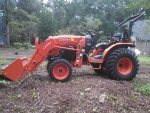The RV antifreeze is propylene glycol. It is safer than automotive ethylene glycol to humans, animals, and the environment. PG is used in food products--check the labels of foodstuffs. That said, it is not 'nontoxic'; it is simply less toxic than the alternative. When in small quantities and diluted it can be relatively safe. A fine point of discussion, but worth considering. You wouldn't want to slug back a gallon of the stuff compared to ice tea.
Using ethylene glycol is fine so long as no leakage occurs. Animals love the sweet taste of EG and it will kill 'em dead due to liver damage. Kids the same.
Concerning water filled tires: Assuming antifreeze (and its inhibitor ingredients package) is not needed. The air cushion in the tire contains oxygen. The oxygen will selectively rust unprotected metal until all the oxygen is 'used up' in creating iron oxide or rust. After all the oxygen is 'used up' forming all the rust it possibly can, then the unprotected metal is effectively passivated and rusting stops. Adding a rust inhibitor should help.
Next time you add air, you introduce more oxygen, under pressure, into the tire. More rusting occurs until that oxygen too is 'used up' in the chemical reaction of forming rust. I mention 'pressure' because oxygen under pressure allows the rusting reaction to occur more quickly due to the reaction rate of the oxidation chemical reaction being increased due to increased pressure. A cutting torch is effectively a high-speed rusting or oxidation reaction, somewhat due to pressure. You don't need the acetylene except to provide heat to start the reaction---try turning off the fuel gas and continuing the cut.
Good discussion. Please post back additional thoughts.


